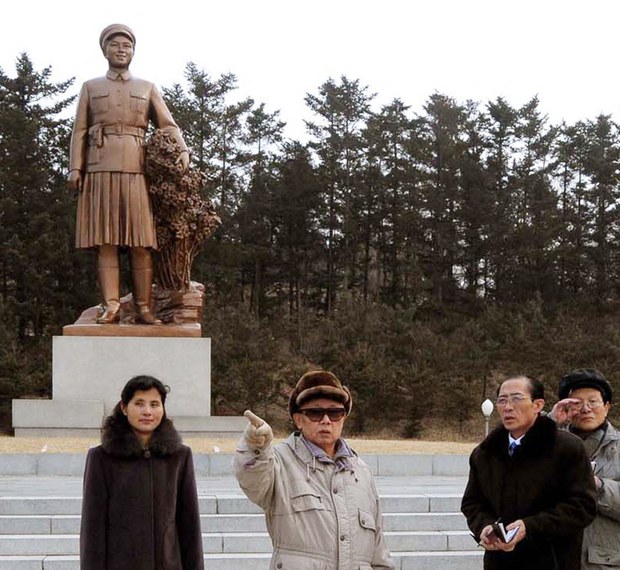No dating at historic sites, North Korea warns young couples
Share

Then-North Korean leader Kim Jong-Il [second from left] stands in front of a statue of his mother, Kim Jong Suk, as he visits her birthplace in Hoeryong, North Korea, in this picture released by North Korea’s official Korean Central News Agency on Feb. 25, 2009.
Increasingly, North Korean young people seeking a romantic rendezvous have been flocking to meticulously maintained historical sites because they are beautiful and lit up at night – appealing in a country with a dearth of parks and lots of rolling blackouts.
But authorities have noticed the trend and warned them to stop what they called disrespectful behavior, threatening to punish lovebirds discovered holding hands at such sites for their “degenerate” actions, sources tell Radio Free Asia.
The warning came after a recent ceremony at the birthplace of Kim Jong Suk, the first wife of North Korean founder Kim Il Sung and a revolutionary hero.
The traditional thatched-roof house – which has been turned into a museum – in the northeastern city of Hoeryong is considered sacred, in a country which confers almost god-like status to its third-generation ruler Kim Jong Un and his family.
The house sits at the end of a carefully maintained white-brick road, with an immaculately primped lawn, surrounded by tall trees – a perfect date spot.
But a provincial official at the ceremony the marking the 74th anniversary of Kim Jong Suk’s death on Sept. 22, 1949, complained that the “ideology of young people has degenerated” because more of them are meeting at the museum, “casually holding hands and openly dating,” a resident of Hoeryong told RFA Korean on condition of anonymity for security reasons.
“He threatened that if such behavior is discovered in the future, one will be severely punished as an anti-party and counter-revolutionary element,” he said.
Another resident of the city who attended the ceremony could understand why young people used the park as a place to meet.
“In Hoeyryong, trees, flowers, and lawns have been planted at Kim Jong Suk’s birthplace and at the Osan historic site where her statue is located, and these are the only spaces that are brightly illuminated at night,” the second resident said. “It’s no wonder that young men and women want to meet up in those places.”
The warning would seem to apply to young people across the country.
There are dozens of monuments and historical sites marking the country’s revolutionary past in practically every city in North Korea that are maintained in a near-pristine state, and many are illuminated at night year-round.
Party heroine
Kim Jong Suk was born in the small house on Dec. 24, 1917, to a poor farming family, and stories of her exploits are routinely praised in the country’s Communist Party propaganda.
“At the memorial event, … they talked about Kim Jong Suk’s childhood and the revolutionary activities in which she participated in the anti-Japanese armed struggle and even risked her life to defend Kim Il Sung,” the first resident said.
The presenter recalled the story of how the couple is said to have been ambushed by a group of enemy soldiers while they were both guerrillas during World War II, he said.
According to the story, Kim Jong Suk immediately jumped in front of her future husband to shield him and the two of them gunned down their attackers.
The attendees were told to follow her example by defending, to the death if needed, the current leader Kim Jong Un, the revolutionary couple’s grandson, the resident said.
Generation gap
The second Hoeryong resident said a generational gap might explain the behavior.
The younger generation was not taught as adamantly to revere the revolutionary sites as sacred like the older generation was, he said. To young people, the sites do not have much meaning other than being beautiful.
The warning was not well received by Hoeryong’s younger citizens, he said.
“The authorities are making threats and warnings [because they fear] that the revolutionary historical sites will be transformed into havens of capitalist culture,” said the resident. “The young people are really unhappy about it.”
Translated by Claire Shinyoung Oh Lee. Edited by Eugene Whong and Malcolm Foster.







